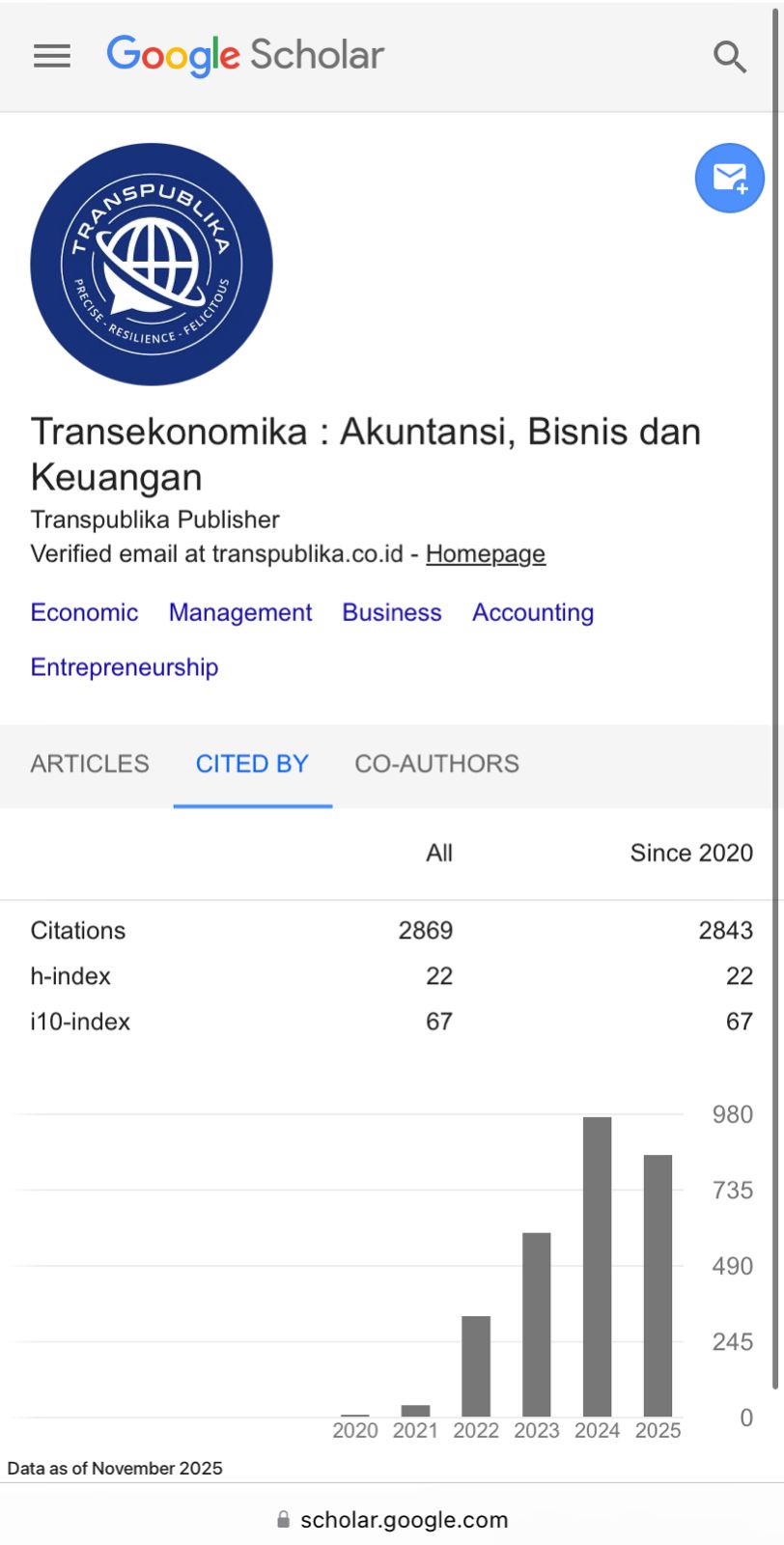THE DYNAMICS OF EXCHANGE RATES, INFLATION, AND TRADE BALANCE IN A SMALL OPEN ECONOMY (CASE STUDY OF SIERRA LEONE)
Abstract
Sierra Leone experiences a persistent trade deficit problem. Currently, there is a vacuum in the literature employing recent data and suitable approaches to address the issue of non-stationarity and dynamic interaction between macroeconomic variables in influencing the trade deficit in Sierra Leone. This study examines the relationship between Sierra Leone's trade balance, inflation, and exchange rate using quarterly data from 2005 Q1 to 2023 Q3. The focus is on understanding how the exchange rate and inflation impact Sierra Leone's trade balance in both the short and long term. To achieve this, the study utilizes the VAR/VECM model to depict the dynamic interaction between the trade balance, exchange rate, and inflation. It also employs Granger Causality analysis to determine the most appropriate ordering among the macroeconomic variables in the model and Impulse Response Function (IRF) analysis to test the hypotheses regarding the trade balance response to exchange rate shocks and inflation. The empirical results confirm the existence of cointegration, indicating a long-term balance between the trade balance, exchange rate, inflation, and other macroeconomic variables such as GDP growth and interest rate differentials. Moreover, the dynamic prediction analysis using the IRF method supports the J-curve hypothesis in Sierra Leone and suggests that inflation can reduce the performance of the trade balance. These findings highlight the need for Sierra Leone to implement a comprehensive strategy to adjust the exchange rate and curb inflation to improve the trade balance and enhance external economic stability.
Downloads
References
Al-Gasaymeh, A., Kasem, J., & Alshurideh, M. (2015). Real Exchange Rate and Purchasing Power Parity Hypothesis: Evidence from ADF Unit Root Test. International Research Journal of Finance and Economics, 14(December), 450–2887. https://www.researchgate.net/profile/Anwar-Al-Gasaymeh/publication/301958831_Real_Exchange_Rate/data/572cd21908ae3736095a3776/Real-Exchange-Rate.pdf
Alhanom, E. (2016). Determinants of Trade Balance in Jordan. NG-Journal of Social Development, 5(2), 24–34. https://doi.org/10.12816/0031165
Bangura, M., Denison-George, C., & Caulker, R. B. (2013). the Impact of Exchange Rate Dynamics on the Trade Balance in Sierra Leone: an Ardl Cointegration Approach. April.
Chuku, C. A. (2009). Measuring the effects of monetary policy innovations in Nigeria: A structural vector autoregressive (SVAR) approach. African Journal of Accounting, Economics, Finance and Banking Research, 5(5), 112–129.
Farlian, T., Handayani, M., Fitriani, N., Fachruddin, R., Zulkifli, N., Phillipe, J., Aceh, B., Aceh, P., Aceh, B., & Intelligent, I. (2019). the_Effect_of_Inflation_and_Interest_Rat. December 2018, 98–104.
Frimpong, S., & Adam, A. (2012). Does financial sector development cause investment and growth? empirical analysis of the case of Ghana. … Business and Enterprise Development, 39634, 67–84. http://journal.ucc.edu.gh/index.php/jobed/article/view/19
Igue, N. N., & Ogunleye, T. S. (2014). Effects of Real Exchange rate on the Trade Balance in Nigeria. African Development Review, 26(2), 347–358. http://dx.doi.org/10.1080/00036846.2014.922673
Iqbal, M., Kalim, R., & Arshed, N. (2019). Domestic and Foreign Incomes and Trade Balance - a Case of South Asian Economies. Asian Development Policy Review, 7(4), 355–368. https://doi.org/10.18488/journal.107.2019.74.355.368
Kalonji, K. D., Gottschalk, J., & Miyajima, K. (2008). Analyzing Determinants of Inflation When there Are Data Limitation:The Case of Sierra Leone. In IMF Working Papers (Vol. 08, Issue 271). https://doi.org/10.5089/9781451871296.001
Keho, Y. (2021a). Determinants of Trade Balance in West African Economic and Monetary Union (WAEMU): Evidence from heterogeneous panel analysis. Cogent Economics and Finance, 9(1). https://doi.org/10.1080/23322039.2021.1970870
Keho, Y. (2021b). Determinants of Trade Balance in West African Economic and Monetary Union (WAEMU): Evidence from heterogeneous panel analysis. Cogent Economics and Finance, 9(1), 1–16. https://doi.org/10.1080/23322039.2021.1970870
Kennedy, O. (2013). Determinants of Balance of Payments in Kenya. 9(16), 112–134.
Krouso, A. I. O., Dinç, D. T., Gökmen, A., & Yazıcı, M. (2019). Money supply, inflation and economic growth in Libya. African J. of Economic and Sustainable Development, 7(2), 89. https://doi.org/10.1504/ajesd.2019.103561
Lal, A. K., & Lowinger, T. C. (2002). Nominal effective exchange rate and trade balance adjustment in South Asia countries $. 13.
Meniago, C., & Eita, J. H. (2017). The effects of exchange rate changes on Sub-Saharan Africa trade. International Journal of Sustainable Economy, 9(3), 213–230. https://doi.org/10.1504/IJSE.2017.085065
Ndiaye, A. (2021). Exchange Rates and Inflation Rates Convergence in ECOWAS. Modern Economy, 12(12), 1726–1747. https://doi.org/10.4236/me.2021.1212088
Nwagu, G. U., Orji, A., Jude, I. O., Ogbuabor, J. E., Anthony-Orji, O. I., & Nwufo, L. C. (2022). Fiscal Policy, Monetary Policy, and Trade Balance Nexus in Nigeria: A New Empirical Evidence. Unisia, 40(1), 129–146. https://doi.org/10.20885/unisia.vol40.iss1.art6
Ousseini, A. M., Hu, X., & Aboubacar, B. (2017). WAEMU Trade and Current Account Balance Deficit Analysis: A Panel VAR Approach. Theoretical Economics Letters, 07(04), 834–861. https://doi.org/10.4236/tel.2017.74060
Shawa, M. J. (2013). Analysis of the Determinants of Trade Balance: Case Study of Tanzania. International Journal of Business and Economics Research, 2(6), 134. https://doi.org/10.11648/j.ijber.20130206.13
Shuaibu, M., & Isah, A. (2020). Exchange Rate Dynamics and Trade Balance in Selected African Countries. Journal of African Trade, 7(1–2), 69. https://doi.org/10.2991/jat.k.201218.001
Swaray, S., & Kabba, O. (2023). Bank Of Sierra Leone Working Paper Series An Asymmetric Model Investigation of Exchange Rate Pass-Through to Domestic Prices in. August, 0–24.
Tarawalie, A. B., Sissoho, M., Conte, M., and Ahortor, C. R. (2012). Exchange rate, inflation and macroeconomic performance in the West African Monetary Zone (WAMZ). WAMI Occasional Paper, 32(2), 32–51.
Tarawalie, A. B., & Kpana, K. A. (2022). Monetary Policy, Exchange Rate Fluctuations and Trade Balance: The Sierra Leone Experience. Modern Economy, 13(03), 425–441. https://doi.org/10.4236/me.2022.133023
Yassin sheikh Ali, A., Nur Sharif Graduate Student, M., Yassin Sheikh Ali, A., & professor, A. (2016). Determinants of Trade Balance in Somalia: Regression Analysis usinTime Series Data Fiscal capacity of Somalia-fragility perspective View project Determinants of Trade Balance in Somalia: Regression Analysis using Time Series Data. 7(12), 62–71. www.iiste.org
Yiheyis, Z., & Musila, J. (2018). The dynamics of inflation, exchange rates and the trade balance in a small economy: The case of Uganda. International Journal of Development Issues, 17(2), 246–264. https://doi.org/10.1108/IJDI-12-2017-0209
Yol, M. A., & Baharumshah, A. Z. (2007). Estimating exchange rate and bilateral trade balance relationships: The experiences of sub-Saharan African countries. South African Journal of Economics, 75(1), 35–51. https://doi.org/10.1111/j.1813-6982.2007.00104.x
Copyright (c) 2024 Ishmael Kamara, Diah Widyawati

This work is licensed under a Creative Commons Attribution 4.0 International License.








.png)







.png)


.png)

.png)















